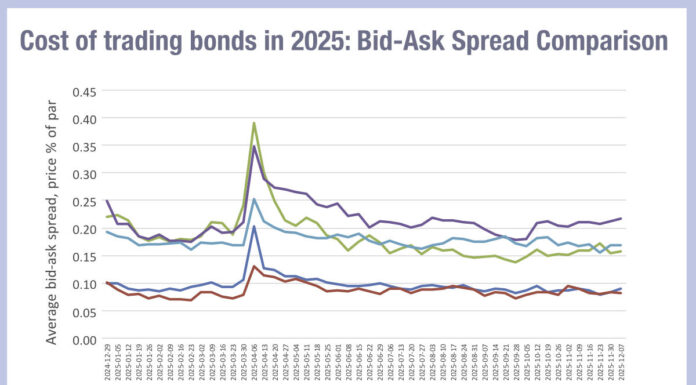Japan’s bond market has long been seen as voice-heavy, with established traditions of relationship-based trading and an aversion to electronic, less personal alternatives. However, as Japanese debt markets continue to grow in volume, the economy makes its way out of a thirty-year era of deflation and global investors get more interested in the region’s offerings, the pressure to electronify trading is ramping up.
While it may be behind international peers, e-trading is a growing force in the market.
JGBs
Across Japanese debt markets, electronic trading is most prominently used in government bonds (JGBs) – especially in the dealer-to-client (D2C) space.
Taichi Shibuya, head of Japan at Tradeweb, commented: “When I joined Tradeweb, the percentage of electronification in the JGB market was in single digits. In 2020 we estimated

D2C electronification to be around 20%; now, it’s between 40% and 50% of the market. I think it’s fair to say that JGBs have reached a tipping point and can be described as almost predominantly traded electronically.”
“I’ve observed electronic market volumes in JGBs increasing quite significantly over the last two years, probably about 40% higher,” concurred Tariq Malik, managing director of fixed income electronic markets at Nomura. “We estimate that, in London hours, the JGB markets are around 70% electronic. In Japan hours, they’re about 40-50% electronic.”
Despite increasing participation and structural change over recent years, the market is not

as mature as its global counterparts. In the US, the leader in the e-trading space, 70-80% of Treasuries are traded electronically.
Even so, it has taken Japan a while to get to this point. One reason for the relative delay in electronification is the Bank of Japan’s (BOJ) massive holding of government debt. This dampens secondary market activity and reduces the drive for structural change in the market. Cultural idiosyncrasies remain limiting, with a historical preference for voice and relationship-based trading discouraging many domestic players from changing their ways.
“Considering how electronification in other markets is further advanced, there is still room to grow for JGBs. According to our own estimates based on conversations with dealers, electronic trading makes up between 70% and 75% of the European government bond and UK Gilt market, and locally our share of total volumes in Australian government bonds is 70% to 80%, including voice tickets,” Shibuya commented.
There is confidence among market participants that the JGB market will keep forging ahead, however. The macro landscape has also encouraged greater use of e-trading, Shibuya says.
“The end of the negative interest rate policy by the BOJ and the macroeconomic tailwind following that was one of the key factors spurring electronification,” he stated.
“We believe Japan may follow this [adoption] trajectory, albeit at a slower pace, as market participants and regulators gradually modernise infrastructure in response to global standards,” added Masahiko Loo, senior fixed income strategist at State Street Global Advisors.
Why?
“Broadly, the reasons for electronification in JGBs are aligned with those in other products,” Malik explained. “Advances in technology, analytics, operational efficiency and the ability for clients to achieve best execution with these techniques are appealing across the board. Automated execution tools for the buy side, supplied by multi-dealer platforms, were originally developed for euro or US dollar markets but are now available and being adopted by clients in yen.”
The majority of JGB e-trading demand has been driven by international investors who were already using such methods elsewhere.
In fact, Shibuya added, e-trading may be even more appealing in JGBs than elsewhere. “Electronic trading lowers the barrier of entry into the Japan market, especially the language barrier. The majority of market making takes place onshore, and not all dealers have sufficient coverage for offshore investors. E-trading helps connect dealers and clients for basic interactions,” he observed.
The JGB market has historically had an exclusivity to it, Shibuya continued, with a preference for voice trading and an appreciation for interpersonal relationships. As such, domestic JGB clients tend to go to domestic dealers.
Where next?
With such an established domestic market, some feel that JGBs will hit a ceiling in how much they can electronify the market.
One reason for this is the large number of regional banks in the country, many of which have not shown an interest in e-trading – or do not have the resources to.
However, Lu Fu, head of e-trading and digital transformation at Mizuho, opined that these

smaller players still have a place in the market. “I think regional companies have a more unique client base. It’s all about the long-term business model,” she said.
“The reason we as a firm invest quite a lot in technology and data analytics globally, particularly around yen rates, is because we target the wider global client base, and that’s where there’s more interest in e-trading. It is always a balance between investment and outcome. If your main targeted group does not really have the demand, or the budget and resources, to bring in e-trading, then it’s not worth it.”
One area that has seen change is how dealers price JGBs, Shibuya reflected. “This part of the market has significantly changed over the years as a result of an increase in electronic trade counts, which was amplified by the use of automated execution tools, such as Tradeweb’s AiEX solution, which we launched more than twelve years ago.”
“The customers trading in the market have become a lot more systematic or algo-driven in their methods, which requires fast pricing and fast execution. It is getting almost impossible for dealers to manually price dozens of trades being sent to their desk simultaneously.”
Despite international investors leading the charge, domestic players are gradually turning to e-trading too.
“In 2020 domestic accounts accounted for probably less than 20% of our JGB volume, but in 2024, domestic accounts accounted for over 30%,” Shibuya noted. “The geographical breakdown of our client base is pretty much in line with the overall market trend nowadays.”
One executive noted that real money domestic accounts are beginning to use Tradeweb and Yensai to e-trade.
Overall, request-for-quote (RFQ) remains the most popular form of e-trading in JGBs, Shibuya stated. “At Tradeweb we also support list trading, which allows clients to submit up to 50-line items to market making participants for pricing and execution at one time, which is being used by both domestic and international accounts,” said Shibuya.
In a departure from international rates trading trends, portfolio trading has not seen much demand according to Shibuya. Tradeweb currently offers the service in the US credit space, and launched an equivalent offering in European government bonds earlier this year. In the US, portfolio trading accounted for 10% of total TRACE volumes across investment grade and high yield bonds in April 2025, according to Morgan Stanley estimates.
One draw of electronifying markets is the assumption that it will improve liquidity.
“Identifying liquidity in JGB issuances is a hot topic for us and our clients,” Shibuya affirms. “The BoJ owns half the market, and it can be very difficult for clients to identify liquidity in a certain bond when it’s sunk in a portfolio and is rarely traded.”
Tradeweb offers a tool allowing dealers to show their axes and allow clients to directly connect that information to their execution process in an attempt to improve this process, he added.
Some are sceptical that the e-trading boom has made much of a difference to the liquidity available in the market, suggesting that there has been more of a benefit around operational efficiency and better execution.
Corporates
While JGBs are beginning to catch up with their global peers, electronification in the corporate bond market is another story.
“We stream yen credit on Bloomberg, and very limited flow is happening electronically,” Fu observed.
“Our Tokyo trading desk has been quite passionate about finding a way for it to take off, but not many international clients have yen credit in their portfolios,” she added. “They need there to be enough yield pick-up. “The electronification of yen credit with domestic clients has been happening slowly.”
“Electronic trading in the credit market remains virtually nonexistent because the market size is small, and the issuance volume is limited as corporate preference for bank loans over bond issuance,” explained Loo. “The Japanese credit market is considerably smaller than that of the US, limiting the scale and incentive for electronic infrastructure investment.”
Corporate bond issuance in Japan, while following seasonal trends, has declined over recent years after COVID pandemic peaks. In May, the total value priced was US$12 billion, the average issuance valued at US$324.9 million.
In secondary markets, according to data from the Japan Securities Dealers Association (JSDA) the majority of corporate bonds traded in the country 2025 to date have had traded face value amounts below 500 million yen – approximately US$3.5 million or €3 million.
Some suggest that e-trading is simply not a good fit for Japanese credit markets, with one executive suggesting that market nuances are not well-served by e-trading protocols. One such nuance is the tendancy among domestic clients to favour long-only offers.
Fu explains, “due to the absence of a repo market in JPY credit, bonds can only be sold if already held, limiting dealers’ inventory. This makes it difficult for clients to compare dealers when buying, as they often rely on what dealers have available. However, clients selling bonds can still put dealers in competition. Most expected future flow is on the sell side, so buying activity is unlikely to be competitive and will mainly serve straight-through processing (STP) purposes.”
For its part, the JSDA is currently operating an initiative to improve the ability for firms with relatively high credit risk to issue corporate bonds, increasing volumes.
“The scale and incentive for electronic infrastructure investment is limited,” Loo commented. “There is also a strong buy-and-hold culture, particularly among domestic life insurers and pension funds, which reduces secondary market activity.”
For his part, Malik remains optimistic. “Looking to the future, I think we’ll see continual technological enhancements, many electronic trading protocols that are used in other markets will most likely be adopted in the Japanese market. We’ve certainly seen this in the interest rate swap space, where almost all of the same protocols used in euro and dollar are now used in yen,” he affirmed.
While electronic trading continues to grow in Japan, the country’s unique nature means that not all the trends that have been set by the US and, increasingly, Europe, will carry through.
©Markets Media Europe 2025












